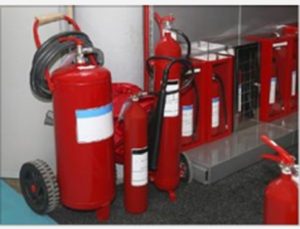
Here are ways for you to clean up different kinds of fire extinguisher residue.
Safety with fire extinguishers is something that a lot of people like to discuss, and knowing how to handle these devices is integral to the safety of everyone in the instance of a fire emergency. For those who have used fire extinguishers before, you feel amazing when you’re able to put out a fire and prevent further damage. With that said, you’ll still have to deal with the fire extinguisher residue once the fire has been put out. Residue from fire extinguishers comes in a few different varieties, and the methods for cleaning them vary. Here are ways for you to clean up different kinds of fire extinguisher residue.
Dry Chemical Fire Extinguisher Residue
Potassium bicarbonate, sodium bicarbonate, and monoammonium phosphate are the types of agents that dry chemical fire extinguishers use to put out fires. A corrosive powder is generated by these agents, and this powder has to be cleaned up before long. Here is what you should do when you have to clean fire extinguisher residue from these types of extinguishers.
- Use isopropyl alcohol with some warm water to deal with any residue that is stuck. Once this solution has had a couple of minutes to sit, you can wipe the affected area using a damp cloth.
- Residue from potassium bicarbonate and sodium bicarbonate should be handled with a solution that is two percent vinegar and ninety-eight percent hot water. Monoammonium phosphate should also use hot water, but instead, add baking soda to the solution. Again, provide a couple of minutes for the solution to sit, and then let a damp cloth handle the rest.
- Whenever fires happen in kitchens, use dishwater to clean dishes and cooking supplies that have been covered in fire extinguisher residue. Clothing should go in a washing machine if residue is on them.
- To finish the cleaning process, wipe everything down using soap and water, then help dry the area with fans.
Class K Wet Chemical Fire Extinguisher Residue
These kinds of extinguishers are often found in commercial kitchens, and they are supposed to deal with cooking fires. Class K fire extinguishers expel a mist that tames flames and cools down surfaces on which cooking occurs. Before you can make use of your kitchen again, however, you have to get the fire extinguisher residue off of surfaces. Here is how to do it:
- Start by turning off your cooking equipment, and be sure to wear rubber gloves for protection.
- Then, use a rag or a sponge, and wipe fire extinguisher residue off with it combined with hot and soapy water.
- Lastly, just like with dry chemical extinguishers, all cookware and dishes should be rinsed if they were affected by the residue. Ensure that your equipment is totally dry before you turn everything back on.
KEEP YOURSELF SAFE WITH ANDERSON FIRE PROTECTION, INC.
Anderson Fire Protection, Inc. has the expertise and skill to help your home or commercial property for all your fire protection needs. We have been working in the Maryland, Northern Virginia, Southern Pennsylvania, and Washington, D.C. areas for over 25 years. We are known for our top-notch customer service and high-quality results. If you are ready for fantastic fire prevention and protection services, from fire sprinkler installation to fire alarm design and to consult, give us a call at (410) 796-4915 or visit us online.
